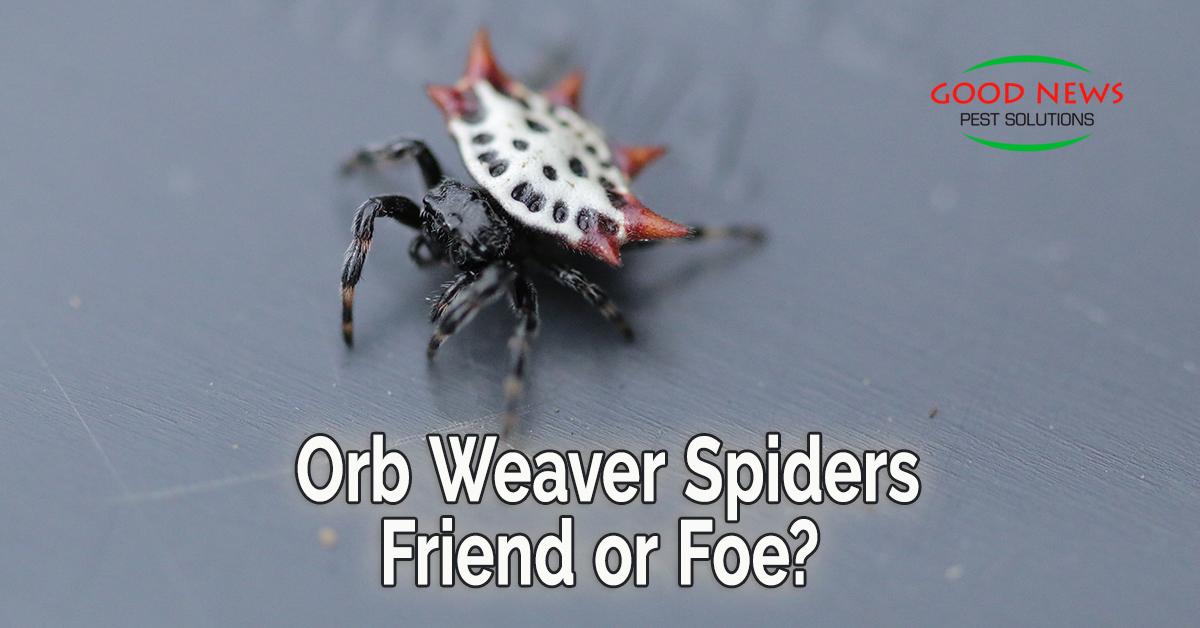
Orb Weaver Spiders - Friend or Foe?
If we asked you to picture an orb weaver spider the chances are, you would be able to – even though each person reading this article might picture a different spider.
The fact is, orb weaver spiders are part of the largest, most varied subgroup of spiders known to man. In fact, unlike some other spiders the orb weavers are not named for their appearance, but rather the spider web they expertly weave.
It’s highly unlikely that you’ve never seen an orb weaver’s web – in pictures at the very least. But we’d guess the majority of us who live on the Gulf Coast of Florida have experienced them. Usually up close and personal, the spider silk stuck to your face or arm after you walked through the near invisible webbing.
There are 8 different orb weaver spiders common in Florida. We’ll talk about half of them today and the other four next week.
Tropical Orb Weaver Spider
One of the largest orb weaver spiders you’ll encounter in the Sunshine State, Tropical orb weavers is the proto-typical arachnid many people picture when they hear the word ‘spider.’ Eriophora ravilla measure between a half an inch and an inch, with males slightly smaller.
The females have reddish-brown legs and heads, typically with a grey abdomen. Some may have humps and/or white spots on their back. They are usually found in the woodlands, orchards, and citrus fruits grooves, building their web after dark. Oh, and that web can measure nearly 20 feet across.
They are not poisonous or in any way harmful to humans, other than the creepy possibility of walking into a web. Once they hatch, they go through a series of molts, leaving their parents behind. They live for about a year, eating small insects like flies and mosquitoes.
Golden Silk Orb Weaver
In order to best catch flying insects for dinner, the Golden Silk orb weaver or Banana orb weaver casts it round net wide – up to 6 feet across and right at eye level. Female Trichonephila clavipes bodies can grow to an inch and a half across – or closer to five inches if you count the legs. Males tend to be much smaller, only a ¼”.
These spiders eat flies, bees, wasps, moths, butterflies – and male banana spiders. They are essential to protecting citrus orchards and pecan farms. Their name comes from their yellowish color, the brightest being about the shade of ripe bananas.
Strangely enough, these spiders can overheat, so they prefer to spin their spiral webs in the shade.
Spiny-Backed Orb Weaver
Gasteracantha cancriformis, pictured in our above graphic, are one of the most recognizable spiders in Southwest Florida. The Spiny-backed orb weaver is small – 3/16th to 3/8th of an inch, but effective. They vary in color from white to yellow, and their spiny protuberances can be black, red or a mix of the two colors.
Also known as crab spiders, they feed off of whiteflies, flies, moths, and beetles that get caught in their webs, many of which are only inches off the ground. They are often spotted in orange groves, and tend to be most common in October and November.
Humpbacked Orb Weavers
Even tinier than their spiny-backed cousin, the Humpbacked orb weaver could almost be mistaken for a beetle trapped in a spider’s web. Eustala anastera are most often seen in the month of April – and are actually much more common in Texas and Alabama than Florida.
The outer ‘shell’ of Humpbacked orb weavers is a dusky grey shade, with small patches of black distributed along the sides. Underneath, their body is a glossy black, with four recognizable yellow spots.
Surprisingly, given their eight eyes, humpbacked orb weavers can’t see very well and both navigate their web and ‘prepare prey’ using the vibrations of the web on their feet. They wrap their leftovers in a cocoon of spider silk for snacking later.
While we don’t want to see them in our houses, spiders are actually the best natural pest control around. But we understand if you’d rather hire us to do it. Our most popular solution, Go Green Perimeter Plus takes care of the typical creepy crawlies that spiders eat, as well as some of the spiders themselves. Questions? You can speak to one of our highly trained technicians about the solution, the cost and how to schedule your first appointment today. Just give us a call!
« Back to Blog
Proudly Serving
Sun City Center, Ruskin, Palmetto, Parrish, Ellenton, Bradenton, Anna Maria, Holmes Beach, Bradenton Beach, Longboat Key, Lakewood Ranch, University Park, Myakka City, Sarasota, Siesta Key, Osprey, Nokomis, Casey Key, Venice, Englewood, North Port, Port Charlotte, Punta Gorda, Arcadia
Things You Can Do
Pay Your Bill Online
Leave Us a Review
Request a Free* Termite Inspection
Stop Mosquito Bites
Get Rid of Rodents
Get a Termite Damage Warranty
Get Pest Control for Your Attic
Get Pest Control for Your Business Request Prayer
Corporate Address
1080 Enterprise Court, Ste A
North Venice, FL 34275
Call Now: (941) 412-9610
Text: (941) 412-9610
Fax: (941) 412-0080
